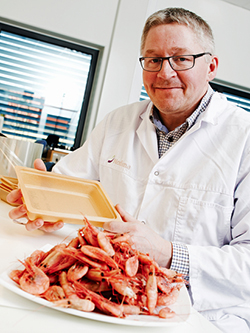Scientists at Nofima are participating in a major EU-financed project in which “active” packaging based on raw materials from shrimp shell improves and conserves food products – and after use the packaging biodegrades. Environmentally stubborn plastic is getting competition from biodegradable packaging made of chitin and chitosan from shrimp shell.
 Director of Research Morten Sivertsvik with Director of Research Morten Sivertsvik with environmentally-friendly packaging made of chitosan from shrimp shell. Nofima is participating in an EU project to research safe and active packaging that not only conserves but also improves the food products. Photo: Steinar Engelsen |
Scientists at Nofima are participating in a major EU-financed project in which “active” packaging based on raw materials from shrimp shell improves and conserves food products – and after use the packaging biodegrades. Environmentally stubborn plastic is getting competition from biodegradable packaging made of chitin and chitosan from shrimp shell.
Nofima’s part of the project equates to around NOK 1 million over a two-year period. Together with the coordinator, Italian company Mavi, the majority of the project involves four medium-sized companies in EU and three research centres.
“Our job is to ensure food contact safety in the project and quantify the effect on bacteria. Chitosan used as an integrated part of the packaging can have an antibacterial effect on the food products,” says Morten Sivertsvik, Director of Research at Nofima’s department for Processing Technology in Stavanger.
“The EU has strict regulations in this area, and our role is to see that the active packaging have a positive and not negative impact on the food products. The chitosan-based fibres that are used in the packaging are based on nanotechnology, so we are talking about minute particles that by no means have to break down so they come in the food products.”
Sivertsvik has worked on packaging technology at Nofima, Europe’s largest food research institute, since 1992.
2/3 of the world’s packaging
The website of the EU project n-Chitopack outlines the perspectives of the shrimp shell-based packaging.
The food sector (including beverage industry) accounts for approximately two-thirds of global packaging. Around 50 percent of this packaging is made of non-biodegradable plastics, which causes ecological imbalance and aesthetic deterioration of nature.
At the same time being a petro-chemical based product, plastics rely on an expensive and non-renewable natural resource with a relatively low environmental factor and high CO2 footprint.
Resource management
Bioplastic is a promising alternative that arises from potential raw materials such as chitosan from the fishery industry, which is mostly used in cosmetic lotions owing to its inherent antibacterial properties.
Chitosan waste exceeds 25 billion tonnes per year and is hazardous due to its high perishability and polluting effect, both on land and at sea. So re-use and up cycling to higher value applications would establish an important step forwards towards resource efficiency, according to the website.
It also emphasizes that there is a requirement for innovation within the small and medium-sized enterprises in the packaging industry in Europe. This industry is under pressure to reduce costs and respond to environmental concerns.
Nanofibre
New research from a research institute in Prague led to a global patent (MAVI) on nanofibre based on chitin, which opens new possibilities for chitin as an ingredient in biopolymers to replace plastic.
The products range from hard bioplastic, which is just as robust as other plastics, to thin film that can come in direct contact with food products. The aim of the Chitopack project is to expand on the positive properties of chitin nanofibre in the development of new food packaging. The packaging is biocompatible, 100 percent naturally biodegradable and satisfies EU requirements for small and medium-sized enterprises. This project will contribute to increased competitiveness in the market and to solving environmental challenges.
Skin cream from shrimp waste
This is not the first time Nofima has researched chitosan from shrimp shell. It began back in the 1980s. In the early 1990s scientists Ragnar L. Olsen and Even Stenberg at the then Fiskeriforskning had a meeting with a visiting Japanese delegation.
“Ragnar bought a lump of chitosan from shrimp shell to that meeting. The Japanese were so fascinated about the quality of this raw material that they ordered a whole container. But we weren’t able to supply so much as we only had enough to fill a test tube,” says Even Stenberg.
“But they understood that the interest in the raw material extracted from waste from the fishery industry was of interest. Among other things this led to commercial production of antimicrobial and moisturising skin lotion.”
“It was the German cosmetic giant Henkel that started the production and commercialisation of the skin lotion. There have been some ownership changes, but the factory in Tromsø is still producing the product, the raw material remains the same and the price per kilo is roughly NOK 1000,” says Even Stenberg. “For us who have been involved in this, it is exciting to see that chitosan as a raw material from shrimp waste is getting new and exciting areas of application.
Source
Nofima, press release, 2013-05-02.
Supplier
Fiskeriforskning
Henkel KGaA
Nofima AS
Share
Renewable Carbon News – Daily Newsletter
Subscribe to our daily email newsletter – the world's leading newsletter on renewable materials and chemicals









